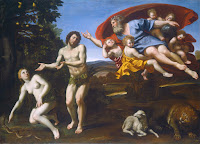Dhr. Seven, Pat Macpherson, Ashley Wells (eds.), Wisdom Quarterly Wiki edit
 |
| Could I play the part of Eve in Asia? |
This is a continuation of a discussion of the Tree & Serpent exhibition coming soon to The Metropolitan Museum of Art in New York. The "serpent" (royal naga) in the Buddhist story is not related to the tree under which the wandering ascetic Siddhartha awoke. But the famous tree of knowledge and talking serpent in the Bible has brought The Met to this tantalizing topic. This got us to thinking about "creation" (the origins of human life on earth, which are told in the Agganna Sutra) and Buddhist cosmology or the shape of things on this plane and in local space.
 |
| We were white? - No, Sumerian. |
Adam's name appears first in Genesis 1 with a collective sense, as "humankind." Subsequently in Genesis 2–3 it carries the definite article ha, equivalent to English "the," indicating that this is "the man" [9] or "the human."
- [It is this iteration, this generation, this version of a genetically modified earthling human, this time around in the greater cyclical reiteration of life in this small slice of the cosmos, our universe, this part of the multiverse, because there are many world-systems or cakkhavalas, round/spiraling worlds (galaxies?) The human plane is far bigger than this plane or planet, solar system, or galaxy.]
In these chapters God fashions "the human" (ha adam) from earth (adamah) [or dust or ground], breathes life [prana, holy spirit, invisible animating force] into its nostrils, and makes it a caretaker over creation [9].
God [who is ALWAYS plural in the Bible] next creates for the human an ezer kenegdo, a "helper corresponding to him," from his side or rib [10].
The word "rib" is a pun in Sumerian -- because this is a Sumerian tale appropriated by later Jewish peoples, as if these things happened to them -- as the word ti means both "rib" and "life" [11, 12].
- [By calling her Eve (yin or moon or night), does it not imply that Adam is the masculine (yang or sun or day) as in the ancient yogic word hatha,* which literally means "sun-moon," and is the same linguistic particle ha.
- *The meaning of Hatha Yoga (and no, it's not “sun & moon”)
She is called ishsha, "woman," because, the text says, she is formed from ish, "man" [10]. The man receives her with joy, and the reader is told that from this moment a man will leave his parents to "cling" to a woman, the two becoming one [sticky] flesh [10]. More
Our world-system (cakkhavala)
 |
| Old flat map, original in Louvre, Paris |
This is the realm of moral choice where future destiny can be guided. The Khana Sutta mentions that this plane is a unique balance of pleasure and pain. It facilitates the development of virtue (e.g., compassion) and wisdom to liberate oneself from the entire cycle or rebirths.
For this reason, rebirth as a human being is considered precious and extremely rare according to the Chiggala Sutta.
The mountain-rings [or ice walls] that engird the axis mundi Mt. Sumeru [Sumer? su-meru = "Good Meru"] are surrounded by a vast ocean [likely a reference to space within this solar system, with this "continent" (dipa, lit. "island") referring to earth, our ring girded by mountains, or planet].
The ocean is in turn surrounded by a circular mountain wall called Cakravāḍa चक्रवाड (Pāli Cakkavāḷa चक्कवाळ, Thai จักรวาล or จกฺกวาฬ), which marks the horizontal limit of the world.
In this "ocean" there are four continents (dipas, islands, other planets, platforms, or places in local space) which are, relatively speaking, small islands in it.
Because of the immensity of the ocean, they cannot be reached from each other by ordinary vessels.
But in the past, when the "world monarchs" (cakravartins) ruled, communication between our world and the other local worlds was possible by means of a treasure called the cakraratna (Pāli cakkaratana, a sort of "flying saucer").
A world monarch and retinue could use such a craft [vimana] to fly through the air between the worlds or rings of this flat plain divided by immense mountain ranges. These four islands are:
- Jambudvīpa (Pali Jambudīpa) is located in the south and is the dwelling of ordinary human beings like us. It is said to be shaped "like a cart" or rather a blunt-nosed triangle with the point facing south. (This description may echo the shape of the coastline of Southern India). It is 10,000 yojanas [1 yojana = 7 miles] in extent (Vibhajyavāda tradition) or has a perimeter of 6,000 yojanas (Sarvāstivāda tradition) to which can be added the southern coast of a length of only 3.5 yojanas. The landmass takes its name from a giant roseapple or jambu tree (Syzygium cumini), 100 yojanas [~700 miles] tall, which grows in the middle. Every continent has one of these giant trees. All buddhas are said to appear on this island or lamp [light, beacon, object shining in space] of Jambu-dvīpa. The people here are five to six feet tall, and their length of life varies between 10 and about [80,000] years (Asankya Aayu). More





















































































































































































































































No comments:
Post a Comment